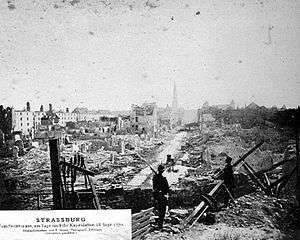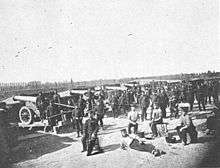Siege of Strasbourg
| Siege of Strasbourg | |||||||
|---|---|---|---|---|---|---|---|
| Part of the Franco-Prussian War | |||||||
 Strasbourg in ruins after the siege | |||||||
| |||||||
| Belligerents | |||||||
|
|
| ||||||
| Commanders and leaders | |||||||
|
|
Jean-Jacques Uhrich | ||||||
| Units involved | |||||||
| Siege Corps | Strasbourg fortress | ||||||
| Strength | |||||||
|
40,000 men 366 guns and mortars |
23,000 men 1,277 artillery pieces | ||||||
| Casualties and losses | |||||||
|
936 177 killed and died of wounds 715 wounded 44 missing 78 horse casualties |
23,000 military Personnel 861 dead Thousands wounded Thousands dispersed 17,562 captured Material 1,277 artillery pieces 140,000 rifles 50 locomotives captured 448 houses destroyed Civilian 341 killed 600–2,000 wounded 10,000 homeless | ||||||
The Siege of Strasbourg took place during the Franco-Prussian War, and resulted in the French surrender of the fortress on 28 September 1870.
After the German victory at Wörth, troops from the Grand Duchy of Baden under Prussian General August von Werder were detached to capture Strasbourg with the help of two Prussian Landwehr divisions which had been guarding the North Sea coast. This 40,000-strong siege corps reached the fortress on 14 August and began to immediately bombard it. The defenses were largely obsolete and 7,000 of the 23,000-strong French garrison were National Guard militiamen. Desiring a quick surrender, the Germans began a terror bombardment to destroy the morale of the civilian population on 23 August. Explosive and incendiary shells were rained down on the city for four days and entire quarters were reduced to ash. Panic developed among the civilians but there was no capitulation.[1]
A shell shortage forced Werder to lower the intensity of the German fire on 26 August and switch to formal siege operations. The Germans dug their way closer to the fortress through trench parallels and destroyed specific sections of the defenses with concentrated bombardments. The siege progressed rapidly, French sortie attempts were defeated and by 17 September the enceinte wall had been breached. At the same time, the defenders' morale was lowered by news of the annihilation of the Army of Châlons at Sedan and the encirclement of the Army of the Rhine in Metz.[2]
On 19 September the Germans captured their first outwork and began a devastating close-range bombardment of the bastions. With the city defenseless and a German assault imminent, the French commander Lieutenant-General Uhrich surrendered the fortress, 17,562 troops, 1,277 artillery pieces, 140,000 rifles, including 12,000 Chassepots, 50 locomotives and considerable stores of supplies into German hands on 28 September. The French National Guards were allowed to disperse. The Germans lost 936 troops. The besiegers expended 202,099 shells, with a weight of about 4,000 tons. Some 861 French soldiers died from all causes by the end of the siege and thousands were wounded. A total of 341 civilians were killed by the bombardment and a further 600–2,000 wounded. An estimated 448 houses were completely destroyed and 10,000 inhabitants were rendered homeless. The German siege operation was successful in clearing up railway lines to German forces in the French interior and freed up several divisions and a corps for operations along the Seine and in the siege of Paris.[3] The deliberate German targeting of civilian morale presaged the total wars of the 20th century.[4]
Background
After the Battle of Wörth, Crown Prince Frederick detached General August von Werder to move south against the fortress of Strasbourg. The city commanded a bridgehead across the Rhine, threatening southern Germany.[5]
Opposing forces
German
Werder's force was made up of 40,000 troops from Prussia, Württemberg and Baden, which lay just across the Rhine from Strasbourg. Werder's force eventually included the Landwehr Guard, the 1st Reserve Division, with one cavalry brigade, 46 battalions, 24 squadrons, 18 field batteries, a separate siege train of 200 field guns and 88 mortars, 6,000-foot artillerymen and ten companies of sappers and miners.[6] The artillery parks at Vendenheim and Kork had a total of 366 guns and mortars, with 320,404 shells, case shot and shrapnel provided.[7]
French
At the time, Strasbourg (along with Metz) was considered to be one of the strongest fortresses in France. Marshal Patrice de MacMahon evacuated Alsace after Wörth and left only three battalions of regulars to hold Strasbourg.[5] Stragglers from Wörth, various other remnant forces, 130 marine infantrymen and elements of the Garde Mobile and National Guard militia improved the garrison's strength to 23,000. The fortress had at least 1,277 guns but no military engineers.[8][5] The French commandant was the 68-year-old Lieutenant-General Jean Jacques Alexis Uhrich.[5]
Siege

On 11 August, Baden's force put Strasbourg under observation. They occupied the nearby town of Schiltigheim, fortified it, and captured the Strasbourg suburb of Königshofen.[5] Werder understood the value of capturing the city, and ruled out a lengthy siege of starvation. He instead decided on a quicker action, bombarding the fortifications and the civilian population into submission.
On 23 August Werder's siege guns opened fire on the city and caused considerable damage to the city and many of its historical landmarks. The Bishop of Strasbourg went to Werder to beg for a ceasefire, and the civilian population suggested paying 100,000 francs to Werder each day he did not bomb the city. Uhrich refused to relent, and soon enough Werder realized he could not keep up such a bombardment with the amount of ammunition he had.
On 24 August, the Museum of Fine Arts was destroyed by fire, as was the Municipal Library housed in the Gothic former Dominican Church, with its unique collection of medieval manuscripts, rare Renaissance books and ancient Roman artifacts.
Werder continued bombing the city, this time targeting selected fortifications. The German siege lines moved rapidly closer to the city as each fortress was turned into rubble. On 11 September, a delegation of Swiss officials went into the city to evacuate non-combatants. This delegation brought in news of the defeat of the French at the Battle of Sedan, which meant no relief was coming to Strasbourg. On 19 September the remaining civilians urged Uhrich to surrender the city, but he refused, believing a defense was still possible. However, that same day Werder stormed and captured the first of the city's fortifications. This event caused Uhrich to reconsider his ability to defend the city. On 27 September Uhrich opened negotiations with Werder, and the city surrendered the following day.
Aftermath
.jpg)
The capture of Strasbourg and the fall of Toul advanced the railway terminus from Germany to the siege lines of Paris considerably to the west.[9] Werder's troops were freed for operations in the French interior against the newly-raised Republican armies.[9]
The German siege artillery expended 202,099 shells before the city, weighing about 4,000 tons.[10] Werder was promoted to General of the Infantry and his Siege Corps was formed into XIV Corps on 30 September.[11] The Guard Landwehr division was sent to the siege of Paris by a railway line that had been opened by the fall of Toul.[11] The 1st Reserve Division remained behind as Strasbourg garrison, the siege artillery was relocated to Vendenheim and the pioneers and fotress guns remained in the city and its vicinity in readiness for future deployments.[11] The rest of XIV Corps, including the Baden Field Division, the 30th and 34th Prussian Regiments, two regiments of Reserve Light Cavalry and three batteries from the 1st Reserve Division, began their march toward Châtillon and Troyes.[11]
Strasbourg was ceded to Germany in the Treaty of Frankfurt on 10 May 1871.
Analysis
The French commandant surrendered the fortress despite plentiful stocks of food and ammunition.[12] The French garrison did not possess sufficient aggressiveness to disrupt the German preparations and left the most probable avenue of attack unprepared.[12] The fortress and the city lacked accommodations capable of withstanding the powerful German breech-loading guns and the French fortress artillery, despite its numerical superiority, was quickly silenced and reduced to simple harassment fire.[12]
The Germans, in contrast, made thorough preparations for every eventuality.[12] While the initial terror bombardment was underway, arrangements for a regular siege operation continued undisturbed.[12] The German siege lines were pushed energetically every day and failings were constantly critiqued and quickly corrected.[12]
Casualties
The French lost 17,562 troops, 1,277 artillery pieces, 140,000 rifles, including 12,000 Chassepots, 50 locomotives and their supplies captured.[13] The French National Guards were dispersed.[13] The Germans lost 936 officers and men, including 177 killed and died of wounds, 715 wounded and 44 missing. Horse losses were 78, of which 37 killed or died of wounds, 29 wounded and 12 missing.[7] Some 861 French soldiers died from all causes by the end of the siege.[14] The German General Staff estimated 2,500 French combatants killed or wounded.[11] A total of 341 civilians were killed by the bombardment and a further 600–2,000 wounded.[15] An estimated 448 houses were completely destroyed and 10,000 inhabitants, including refugees, were rendered homeless.[11][13]
Citations
- ↑ Howard 1991, p. 217.
- ↑ Howard 1991, p. 218.
- ↑ Moltke 1892, p. 139.
- ↑ Howard 1991, pp. 218–219.
- 1 2 3 4 5 Moltke 1892, p. 132.
- ↑ Moltke 1892, pp. 132–133.
- 1 2 German General Staff 1880, p. 13‡.
- ↑ Chrastil 2014, p. 110.
- 1 2 German General Staff 1880, p. 95.
- ↑ German General Staff 1884, p. 205.
- 1 2 3 4 5 6 German General Staff 1880, p. 93.
- 1 2 3 4 5 6 German General Staff 1880, p. 94.
- 1 2 3 Moltke 1892, p. 138.
- ↑ Chrastil 2014, p. 110, of which 270 killed in action, 445 died from wounds, 146 of sickness.
- ↑ Chrastil 2014, p. 220.
References
- Chrastil, Rachel (2014). The Siege of Strasbourg. Cambridge, MA: Harvard University Press. ISBN 978-0-674-72886-8.
- German General Staff (1880). The Franco-German War 1870-71: Part 2; Volume 1. London: Clowes & Sons.
- German General Staff (1884). The Franco-German War 1870–71: Part 2; Volume 3. London: Clowes & Sons.
- Howard, M. (1991) [1962]. The Franco-Prussian War: The German Invasion of France 1870–1871. New York: Routledge. ISBN 0-415-26671-8.
- Moltke, H. (1892). The Franco-German War of 1870-71. New York: Harper.
.jpg)